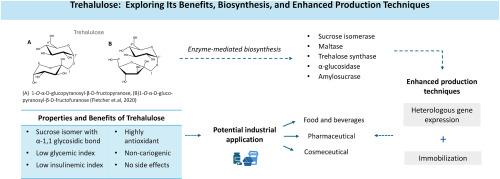曲哈鲁糖:探索其益处、生物合成和强化生产技术。
IF 2.4
3区 化学
Q3 BIOCHEMISTRY & MOLECULAR BIOLOGY
引用次数: 0
摘要
与糖有关的健康问题日益受到关注,激发了研究人员寻找蔗糖替代品的兴趣。曲哈鲁糖是蔗糖的一种有益结构异构体,是一种非致龋糖,血糖和胰岛素指数较低。除了具有作为蔗糖替代品的潜力外,曲哈鲁糖还具有很高的抗氧化性,使其在各种工业应用中颇具吸引力。尽管三氟氯菊糖具有众多优点,在各行各业都有潜在应用,但由于缺乏对其特性和实际用途的研究,工业上对三氟氯菊糖的采用仍有待确定。本综述旨在全面概述三氟氯菊糖的特性,强调其对健康的益处。此外,还探讨了作为甜味剂和还原剂的三氟氯菊糖的工业前景,尤其是在食品、饮料、制药和化妆品领域。此外,该综述还深入探讨了三聚氰胺的来源以及能够生产三聚氰胺的各种生物。这种糖的生物合成主要涉及酶介导的过程。因此,本综述探讨了这些酶的特性、机制以及与三卤戊糖生产相关的基因的异源表达。本综述中讨论的策略可加以改进和应用,以便在未来建立高效合成三卤戊糖的三卤戊糖生物工厂。随着进一步的研究和开发,三卤纤维素有望成为各行各业的宝贵成分。本文章由计算机程序翻译,如有差异,请以英文原文为准。

Trehalulose: Exploring its benefits, biosynthesis, and enhanced production techniques
The increasing concern over sugar-related health issues has sparked research interest in seeking alternatives to sucrose. Trehalulose, a beneficial structural isomer of sucrose, is a non-cariogenic sugar with a low glycemic and insulinemic index. Besides its potential as a sugar substitute, trehalulose exhibits high antioxidant properties, making it attractive for various industrial applications. Despite its numerous advantages and potential application in various sectors, the industrial adoption of trehalulose has yet to be established due to lack of studies on its characteristics and practical uses. This review aims to provide a comprehensive overview of the properties of trehalulose, emphasizing its health benefits. The industrial prospects of trehalulose as sweetener and reducing agent, particularly in food and beverages pharmaceutical, and cosmeceutical sectors, are explored. Additionally, the review delves into the sources of trehalulose and the diverse organisms capable of producing trehalulose. The biosynthesis of this sugar primarily involves an enzyme-mediated process. Thus, these enzymes' properties, mechanisms, and the heterologous expression of genes associated with trehalulose production are explored. The strategies discussed in this review can be improved and applied to establish trehalulose bio-factories for efficient synthesis of trehalulose in the future. With further research and development, trehalulose holds promise as a valuable component across various industries.
求助全文
通过发布文献求助,成功后即可免费获取论文全文。
去求助
来源期刊

Carbohydrate Research
化学-生化与分子生物学
CiteScore
5.00
自引率
3.20%
发文量
183
审稿时长
3.6 weeks
期刊介绍:
Carbohydrate Research publishes reports of original research in the following areas of carbohydrate science: action of enzymes, analytical chemistry, biochemistry (biosynthesis, degradation, structural and functional biochemistry, conformation, molecular recognition, enzyme mechanisms, carbohydrate-processing enzymes, including glycosidases and glycosyltransferases), chemical synthesis, isolation of natural products, physicochemical studies, reactions and their mechanisms, the study of structures and stereochemistry, and technological aspects.
Papers on polysaccharides should have a "molecular" component; that is a paper on new or modified polysaccharides should include structural information and characterization in addition to the usual studies of rheological properties and the like. A paper on a new, naturally occurring polysaccharide should include structural information, defining monosaccharide components and linkage sequence.
Papers devoted wholly or partly to X-ray crystallographic studies, or to computational aspects (molecular mechanics or molecular orbital calculations, simulations via molecular dynamics), will be considered if they meet certain criteria. For computational papers the requirements are that the methods used be specified in sufficient detail to permit replication of the results, and that the conclusions be shown to have relevance to experimental observations - the authors'' own data or data from the literature. Specific directions for the presentation of X-ray data are given below under Results and "discussion".
 求助内容:
求助内容: 应助结果提醒方式:
应助结果提醒方式:


